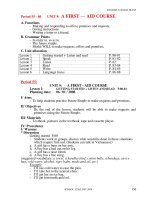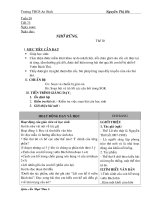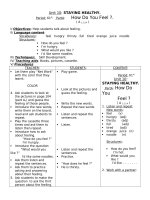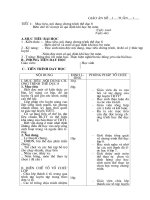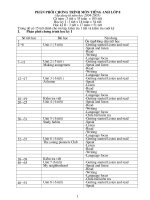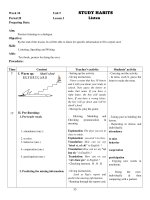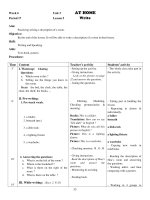Giao An 8 U10
Bạn đang xem bản rút gọn của tài liệu. Xem và tải ngay bản đầy đủ của tài liệu tại đây (396.1 KB, 15 trang )
Unit 10 RECYCLING
Aim:
Helping students:
- Give and respond to instructions.
- Talk about feelings.
- Write a set of instructions.
Language focus:
1. Passive forms.
2. Adjectives followed by: an infinitive and a noun clause.
3. Simple future.
4. Present simple.
Unit Allocation:
Lesson 1 Getting Started
Listen and Read
L. Focus 3
Listening & reading the dialogue for details about how
to protect the environment and practice the structure: S
+ be + adj. + to-infinitive …
Lesson 2 Speak
Listen
Practice in giving and responding to instructions.
Listening for specific information about making
compost.
Lesson 3 Read Reading for details about how things are recycled.
Lesson 4 Write
L. Focus 4
Writing a set of instructions on how to recycle used
things.
Lesson 5 Language Focus 1,2 Passive form in Present Simple and Future simple.
126
Week: 21 Unit 10 RECYCLING
Period: 61 Lesson 1 Getting Started Listen and Read
Preparing Date: 25.01.08 Language focus 3
Aim:
Reading for details and practicing the structure: S + be + adj. + to-infinitive
Objective:
By the end of the lesson, Ss will be able to know about how to protect the environment and practice the
structure: S + be + adj. + to-infinitive
Skills:
Reading, Writing, Speaking and Listening.
Aids:
Text book, posters for doing the exer.
Procedure:
Time Content Teachers activity Students activity
5
15
I. Warm up: Brainstorming
use tree leave to wrap food
ways to reduce
the garbage
Possible answers:
- use cloth bags
- use plastic bags again.
- use paper to make toys.
- collect garbage to make
fertilizers.
II. Presentation:
1. Pre-teach vocab.
1. a representative:
2. (to) protect:
3. (to) reduce:
4. (to) reuse:
5. (to) follow:
- Setting up the activity.
- Giving instructions.
Work in pairs to think of the
ways to reduce the garbage.
- Modeling.
- Writing Ss ideas on the board.
- Correcting and feeding back.
- Eliciting, Modeling, Checking
pronunciation & meaning.
Translation: How do we say ủaùi
dieọn in English ?
Explanation: to keep someone
from danger.
Explanation: to make less &
smaller.
Synonym: Give me the verb that
means: use again.
Translation: How do we say
laứm theo in English ?
- The whole class take part
in answering the questions.
- Telling the ideas to the
teacher.
- Taking part in building the
lesson.
- Repeating in chorus and
individually.
a representative
to protect
to reduce
to reuse
to follow
- Copying new words in
127
12’
11’
2. Set the scene:
3. True or False Prediction:
a. Miss Blake asks the students to
remember 3 things: reduce, reuse
and recycle.
b. It is not difficult to remember the
three words begin with R.
c. We shouldn’t use cloth bags.
4. Listen & answer:
Keys:
a. T b. T c. F
5. Listen and repeat:
6. Practice with a partner:
7. Target Language:
It is not difficult to remember the three
words begin with R.
• Form:
It + be (not) + adj. + to – infinitive…
• Use:
III. Practice: word - cue drill
(Exer. 3 Page 96)
Model:
Ba: Turn right, then left, then right and
then left again.
Nam: It’s difficult to follow your
directions. Can you start again, please ?
Keys:
1. It’s easy to understand.
2. It’s hard to believe.
3. It’s dangerous to go.
4. It’s important to wait.
IV. Production:
1. Doing the exer. 2. Page 90:
Keys:
- Checking memory: R . O . R
- Setting the scene.
A representative from Friends of
the Earth, Miss Blake, is talking to
the students of Quang Trung
School. Friends of the Earth
shows people how to protect the
environment and save natural
resources.
- Writing Ss’ prediction on the
board.
- Letting Ss listen to the tape
twice.
- Letting Ss listen to the tape the
third.
- Giving feedback.
- Asking Ss to repeat the sentence
b.
- Presenting new target language.
- Checking concept.
Meaning: Tell me the Vietnamese
meaning of the sentence.
Form: How do we form this
pattern ? What is after the adj. ?
Use: When do we use this form
?
Pronunciation: Where do we
have a heavy tone on the
sentence ?
- Setting up the activity.
- Giving instructions.
Complete the dialogues by using
the words in the box.
- Modeling.
- Monitoring & assisting Ss.
- Giving feedback.
- Asking Ss. to practice the
dialogues in 2 groups, then in
pairs.
- Giving instructions.
Read the dialogue silently to
notebooks.
- Listening to the teacher &
predicting which sentences
are True and which are
False. (books shut)
- Giving teacher the
prediction.
- Listening to the tape and
checking the prediction.
- Comparing the answers
with a partner.
- Correcting the wrong ans.
- Repeating the sentence b.
in chorus & individually.
- Listening & answering the
questions to show how to
know the new pattern.
- Copying new pattern in
notebooks.
- Listening & taking part in
the model with teacher.
- Completing the dialogues
individually.
- Comparing with a partner.
- Practicing in 2 groups.
- Practicing in close pairs,
then open pairs.
- Reading the dialogue
silently and answering the
questions.
128
2’
a. Reduce means not buying products
which are over packed.
b. We can reuse things like envelopes,
glass, plastic bottles and old plastic bags.
c. Recycle means not just throwing things
away. Try and find another use for them.
d. We can look for information on
recycling things by having a contact with
an organization like Friends of the Earth.
V. Homework:
Copying the complete dialogues of the
exer. 3 on page 96 in notebooks.
give the answers to the questions
of the exer. 2 on page 90.
- Modeling.
- Monitoring & assisting Ss.
- Correcting & conducting
feedback.
- Setting the tasks for Ss.
- Giving instructions.
Copy the complete dialogues of
the exer. 3 on page 96 in
notebooks.
- Comparing the answers
with a partner.
- Correcting the wrong
answers if necessary.
- Taking notes in notebooks.
Week 21 Unit 10 RECYCLING
Period 62 Lesson 2 Speak – Listen
Preparing Date: 25.01.08
Aim:
Practicing in making and responding to instructions and listening for specific information .
Objective:
By the end of the lesson, Ss will be able to know how to make & respond to instructions and listen for specific
information about making compost.
Skills:
Speaking, Listening and Writing.
Aids:
Text book, Cassette tape, Posters for doing the exer.
Procedure:
Time Content Teacher’s activity Students’ activity
5’
I. Warm up: Kim’s game
old newspaper book bottle
glasses plastic bag food can
drinking tin shoes clothes schoolbag
jars vegetable used paper
- Setting up the activities.
- Giving instructions.
Look at the words in the poster in a
minute and try to remember them as
much as possible.
- Modeling.
- Dividing Ss. into 2 groups and
asking them to write the words on
the board.
- The whole class take
part in the activity.
- Working in 2 groups to
look at the words in the
poster in a minute and
try to remember them as
much as possible.
- Ss. from two groups
write the words on the
129
8’
20’
II. Pre-speaking:
1. Pre-teach vocab.:
1. fertilizer (unc.):
2. compost (unc.):
3. fabric (unc.):
4. leather (unc.):
III. While-speaking:
1. Classifying the things in correct
groups:
• Possible answers:
Groups Items
Paper used paper, books, cardboard
boxes, old newspaper.
Glass bottles, glasses, jars.
Plastic plastic bags, plastic bottles.
Metal food cans, drinking tins.
Fabric clothes, cloth bags, material.
Leather shoes, sandals, schoolbags.
Vegetable
matter
fruit peels, vegetables, rotten
fruits.
2. Practice speaking: Mapped dialogue
Which group do
clothes belong to ?
What can we do
with them ?
Is fruit vegetable
matter ?
Put them in fabric.
We can recycle
them and make
them into paper.
- Feeding back & congratulating the
group has more and correct words.
- Eliciting, Modeling, Checking
pronunciation & meaning.
Explanation: The things farmers
use to plants grow well.
Explanation: What do you call the
fertilizer made from tree leaves,
vegetables matter ?
Explanation: The material we use to
make clothes.
Explanation: The material we use to
make shoes, sandals…
- Checking memory: R . O . R
- Setting the scene by giving the
pictures of the things on page 91 and
asking them to classify the things in
the correct groups.
- Modeling.
- Writing Ss’ answers on the board.
- Putting the mapped dialogue chart
on the board.
- Eliciting the exchange from the Ss.
- Monitoring & assisting Ss.
- Asking Ss to practice in close pairs
and then open pairs.
- Asking Ss. to work in close pairs to
make the same dialogues by
replacing the underlined parts with
the other words in the table above.
- Modeling.
- Monitoring & assisting Ss.
- Feeding back.
board.
- Congratulating the
winner.
- Taking part in building
the lesson.
- Repeating in chorus
and individually.
fertilizer
compost
fabric
leather
- Copying new words in
notebooks.
- Listening to the teacher
and taking part in the
model.
- Working in pairs to
classify the things in the
correct groups.
- Telling the teacher
about the answers.
- Listening to the
teacher and taking part
in building the dialogue.
- Practice the dialogue
in 2 groups then in close
pairs.
- Working in pairs to
make the dialogues by
replacing the underlined
parts with the other
words in the table above.
- Some pairs speak out
their dialogues in front
of class.
130
10’
2’
What will we do
with it ?
That’s right.
We make it into
compost.
IV. Post-speaking: Listening
• Answer keys:
a. A b. B c. A d. B
IV. Homework:
• Making the same dialogues
about classifying the waste things.
- Setting the scene by asking Ss.
some questions about making
compost.
- Giving instructions.
You are going to listen to an expert
who gives the instructions to make
compost. Read the 4 questions in the
lesson part on page 91.
- Running through the 4 questions
and the answers.
- Letting Ss. listen to the tape twice.
- Letting Ss. listen to the tape again.
- Giving feedback.
- Setting the tasks for Ss.
- Giving instructions.
Making the same dialogues about
classifying the waste things.
Modeling.
- Listening and trying to
understand the situation.
- Reading the four
questions in the lesson
part.
- Listening to the tape
and choosing the
answers four each
question.
- Comparing the answers
with a partner.
- Correcting the wrong
answers if necessary.
- Taking notes in
notebooks.
131
